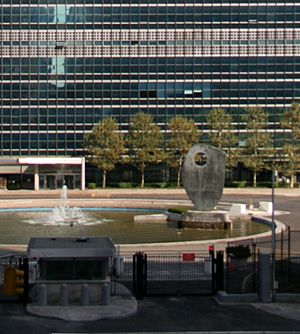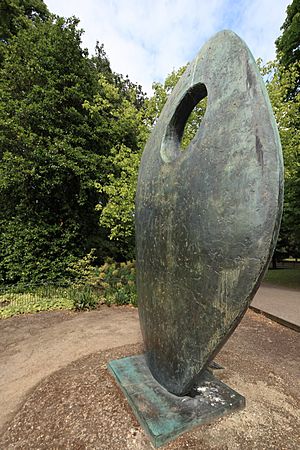Single Form facts for kids
Single Form is a huge bronze sculpture by the famous British artist Barbara Hepworth. It's her biggest artwork ever made. You can see it in New York City at the United Nations Headquarters. It stands in a round pool of water near the United Nations Secretariat Building. This sculpture has been there since 1964.
There are also smaller copies of this sculpture, called Single Form (Memorial). You can find one in Washington, D.C. at Johns Hopkins University. Another is in Battersea Park in London. The London sculpture is so important that it's protected as a special historic building.


What the Sculpture Looks Like
This sculpture has a unique shape. It is mostly flat and looks a bit like an oval. Near the top, there's a round hole that goes right through it.
The surfaces of the sculpture are rough and have marks. You can see three lines on each side. One line goes up and down, and two go across. These lines show how the sculpture was put together from different pieces.
Artists and critics have shared their ideas about what Single Form might mean. One critic, Edwin Mullins, thought it could look like a body, an eye, or even a hand. Another, Dore Ashton, saw it as a "vision of the cosmos," like a view of the universe.
Why Was Single Form Made?
The Single Form sculpture was created to remember a very important person. It was commissioned by the Jacob and Hilda Blaustein Foundation. They wanted to honor Dag Hammarskjöld, who was the Secretary-General of the United Nations.
Sadly, Mr. Hammarskjöld died in a plane crash in Africa in 1961. He was a big fan of Barbara Hepworth's art. He even had one of her earlier sculptures, also called Single Form, in his office at the United Nations. He had even talked with Hepworth about her making a sculpture for the UN. So, this artwork became a special way to remember him.
How the Sculpture Was Created
Barbara Hepworth began working on ideas for this bronze sculpture in 1961. She made several related pieces before the final large one.
One early bronze was Single Form (Chûn Quoit). She also made a wooden sculpture called Single Form (September). This wooden piece has a round dip near the top. Hepworth named it "September" because she heard about Mr. Hammarskjöld's death in September 1961. This wooden sculpture is now at the Barbara Hepworth Museum in St Ives, Cornwall.
Hepworth then made a larger bronze, about 10 feet (3 meters) tall, called Single Form (Memorial). This version had a hole instead of just a dip. The first Single Form (Memorial) was shown in an art exhibition in 1963. It was later given to Johns Hopkins University in Washington, D.C. A second copy was bought for Battersea Park in London, where it still stands today.
To create the huge Single Form for New York, Hepworth doubled the size of Single Form (Memorial). She made a full-size model out of wood and plaster. The final sculpture was cast in seven pieces at the Morris Singer foundry in London. These pieces were then put together.
The finished sculpture is about 21 feet (6.4 meters) tall and weighs 5.5 tons! It was put in place in New York in May 1964. It stands on a granite base in a large, round pool of water. This pool, which has a fountain, was built with money donated by children from the United States. The sculpture was officially shown to the public on June 11, 1964.

